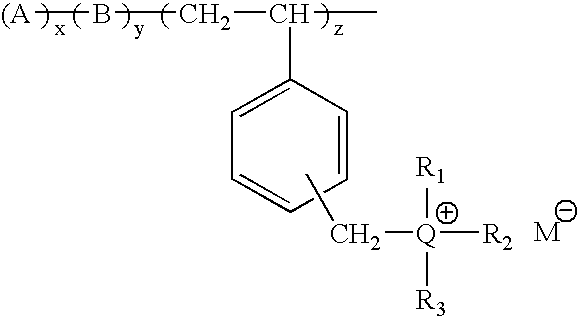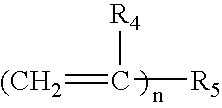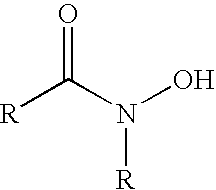Composition comprising metal-ion sequestrant
a technology of sequestrant and metal ions, applied in the field of matter, can solve the problems of inability to dispose of items containing these materials, affecting the color or taste, and harmful to the person using or consuming those items, and achieves the effects of convenient application, high capacity for metal-ions, and efficient removal of metal-ions
- Summary
- Abstract
- Description
- Claims
- Application Information
AI Technical Summary
Benefits of technology
Problems solved by technology
Method used
Image
Examples
examples
(1-6) and Comparison Examples C-1, C-2
[0068]A “model” biological liquid medium was prepared as follows: 25.0 g of sucrose, 25.0 g of glucose, 0.50 g of NaCl and 0.25 g of citric acid, were carefully dissolved in 500.0 ml of pure distilled water to produce a solution having: 5% sucrose, 5% glucose, 1000 ppm NaCl, and 500 ppm citric acid. The “model” biological liquid medium was then divided into two equal parts and one was adjusted to pH 4.0 and the other adjusted to pH 6.0 with 2.5 N aqueous NaOH. The two separate solutions were then spiked with Fe by the addition of the appropriate amount of a 500 ppm Fe3+ solution so that the final Fe concentration of each was 1.8 parts per million. 5 cm×5 cm pieces of the coatings prepared as described above were then contacted with 20.0 ml of the model biological liquid medium, at pH 4.0 and at pH 6.0. The pieces of the coatings were left in contact with the medium for the time indicated in Table 2, and a 1.0 ml aliquot of the medium was taken f...
PUM
| Property | Measurement | Unit |
|---|---|---|
| particle size | aaaaa | aaaaa |
| particle size | aaaaa | aaaaa |
| size | aaaaa | aaaaa |
Abstract
Description
Claims
Application Information
 Login to View More
Login to View More - R&D
- Intellectual Property
- Life Sciences
- Materials
- Tech Scout
- Unparalleled Data Quality
- Higher Quality Content
- 60% Fewer Hallucinations
Browse by: Latest US Patents, China's latest patents, Technical Efficacy Thesaurus, Application Domain, Technology Topic, Popular Technical Reports.
© 2025 PatSnap. All rights reserved.Legal|Privacy policy|Modern Slavery Act Transparency Statement|Sitemap|About US| Contact US: help@patsnap.com



